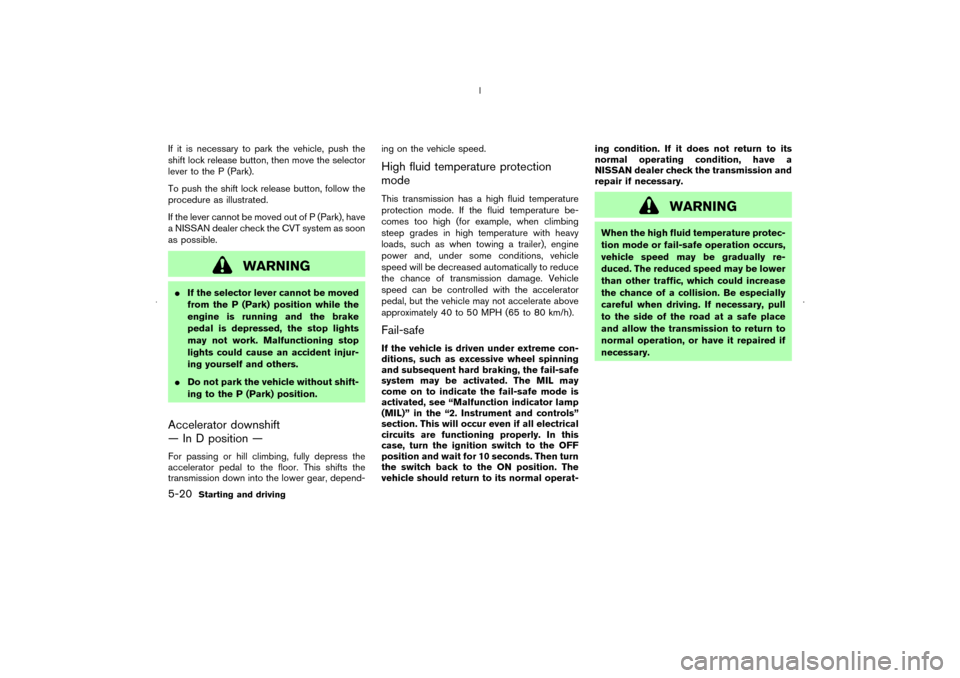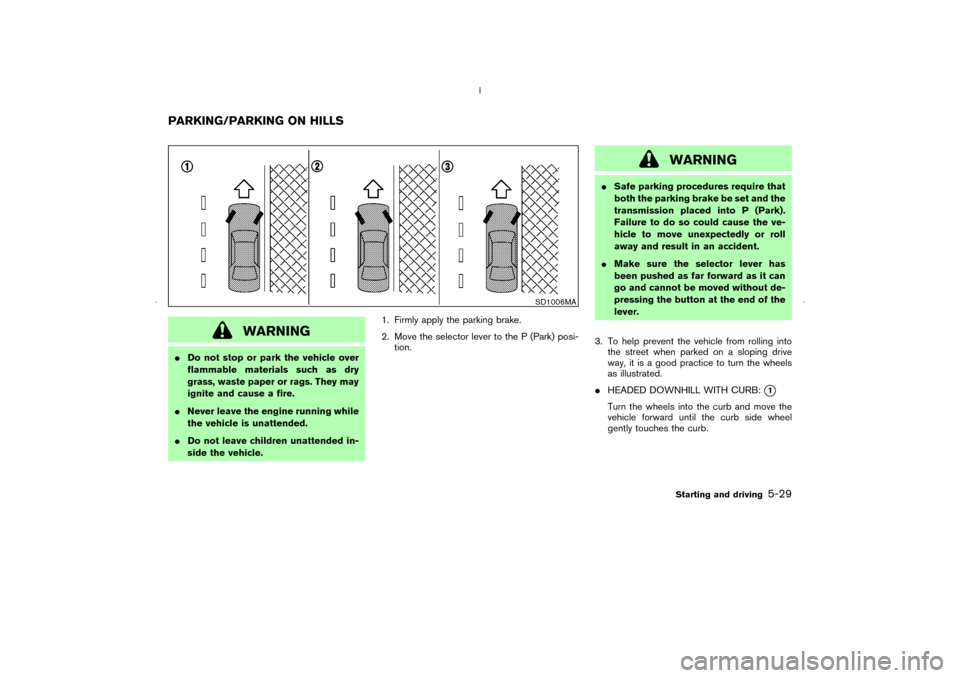Page 220 of 341

M4 (Fourth), M3 (Third) and M2 (Second):
Use for hill climbing or engine braking on down-
hill grades.
M1 (First):
Use this position when climbing steep hills
slowly or driving slowly through deep snow,
sand or mud, or for maximum engine braking on
steep downhill grades.
�Remember not to drive at high speeds for
extended periods of time in lower than M6
range. This reduces fuel economy.
�When shifting up, move the selector lever to
the + (up) side. (Shifts to higher range.)
�When shifting down, move the selector lever
to the − (down) side. (Shifts to lower range.)
�Moving the selector lever to the same side
twice will shift the ranges in succession.
However, if this motion is rapidly done, the
second shifting may not be completed prop-
erly.
�In the manual shift mode, the transmis-
sion automatically shifts down to M1
(First) before the vehicle comes to a
stop. When accelerating again, it is nec-
essary to shift up to the desired range.
�When canceling the manual shift mode, re-
turn the selector lever to the D position. Thetransmission returns to the normal driving
mode.
�In the manual shift mode, the transmis-
sion may not shift to the selected gear.
This helps maintain driving performance
and reduces the chance of vehicle dam-
age or loss of control.
�When the CVT fluid temperature is extremely
low, the manual shift mode may not work and
automatically shift as a drive mode. This is not
a malfunction. In this case, return the selector
lever to D range and drive for a while and then
shift to the manual shift mode.
�When the CVT fluid temperature is high, the
shift range may upshift in lower rpm than
usual. This is not a malfunction.
Shift lock releaseIf the battery is discharged, the selector lever
may not be moved from the P (Park) position
even with the brake pedal depressed.
To move the selector lever, push the shift lock
release button while depressing the foot brake
and applying the parking brake. The selector
lever can be moved to N (Neutral). This allows
the vehicle to be moved if the battery is dis-
charged, after releasing the parking brake.
If the battery is discharged in N (Neutral), D
(Drive) or Manual shift mode, the selector lever
may not be moved to the P (Park) position.
SSD0352
Starting and driving
5-19
�
05.8.26/Z50-D/V5.0
�
Page 221 of 341

If it is necessary to park the vehicle, push the
shift lock release button, then move the selector
lever to the P (Park).
To push the shift lock release button, follow the
procedure as illustrated.
If the lever cannot be moved out of P (Park), have
a NISSAN dealer check the CVT system as soon
as possible.
WARNING
�If the selector lever cannot be moved
from the P (Park) position while the
engine is running and the brake
pedal is depressed, the stop lights
may not work. Malfunctioning stop
lights could cause an accident injur-
ing yourself and others.
�Do not park the vehicle without shift-
ing to the P (Park) position.Accelerator downshift
— In D position —For passing or hill climbing, fully depress the
accelerator pedal to the floor. This shifts the
transmission down into the lower gear, depend-ing on the vehicle speed.
High fluid temperature protection
modeThis transmission has a high fluid temperature
protection mode. If the fluid temperature be-
comes too high (for example, when climbing
steep grades in high temperature with heavy
loads, such as when towing a trailer), engine
power and, under some conditions, vehicle
speed will be decreased automatically to reduce
the chance of transmission damage. Vehicle
speed can be controlled with the accelerator
pedal, but the vehicle may not accelerate above
approximately 40 to 50 MPH (65 to 80 km/h).Fail-safeIf the vehicle is driven under extreme con-
ditions, such as excessive wheel spinning
and subsequent hard braking, the fail-safe
system may be activated. The MIL may
come on to indicate the fail-safe mode is
activated, see “Malfunction indicator lamp
(MIL)” in the “2. Instrument and controls”
section. This will occur even if all electrical
circuits are functioning properly. In this
case, turn the ignition switch to the OFF
position and wait for 10 seconds. Then turn
the switch back to the ONposition. The
vehicle should return to its normal operat-ing condition. If it does not return to its
normal operating condition, have a
NISSAN dealer check the transmission and
repair if necessary.
WARNING
When the high fluid temperature protec-
tion mode or fail-safe operation occurs,
vehicle speed may be gradually re-
duced. The reduced speed may be lower
than other traffic, which could increase
the chance of a collision. Be especially
careful when driving. If necessary, pull
to the side of the road at a safe place
and allow the transmission to return to
normal operation, or have it repaired if
necessary.
5-20
Starting and driving
�
05.8.26/Z50-D/V5.0
�
Page 230 of 341

WARNING
�Do not stop or park the vehicle over
flammable materials such as dry
grass, waste paper or rags. They may
ignite and cause a fire.
�Never leave the engine running while
the vehicle is unattended.
�Do not leave children unattended in-
side the vehicle.1. Firmly apply the parking brake.
2. Move the selector lever to the P (Park) posi-
tion.
WARNING
�Safe parking procedures require that
both the parking brake be set and the
transmission placed into P (Park).
Failure to do so could cause the ve-
hicle to move unexpectedly or roll
away and result in an accident.
�Make sure the selector lever has
been pushed as far forward as it can
go and cannot be moved without de-
pressing the button at the end of the
lever.
3. To help prevent the vehicle from rolling into
the street when parked on a sloping drive
way, it is a good practice to turn the wheels
as illustrated.
�HEADED DOWNHILL WITH CURB:
�1
Turn the wheels into the curband move the
vehicle forward until the curbside wheel
gently touches the curb.
SD1006MA
PARKING/PARKING ON HILLS
Starting and driving
5-29
�
05.8.26/Z50-D/V5.0
�